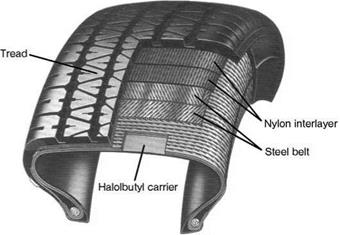The wide range of structural elements made from elastomer composite materials has become an important and indispensable part of everyday life, due to their resilient or elastic deformation behavior when subjected to mechanical stress. The mechanical joining techniques used for metals are often not suitable for rubber materials, and indeed the adhesive bonding of rubber with latex is one of the most ancient adhesive applications used by mankind. Latex or rubber milk produced from India rubber trees (a dispersion of natural latex in water) was first used about 8000 years ago to produce elastic composites for tool manufacture, and served later to join textile materials or to make them water-repellent.
The use of rubber on a technical level dates back to 1840, when Charles Goodyear discovered that natural rubber could be crosslinked (‘vulcanized’) by adding sulfur prior to any thermal treatment. Shortly afterwards, Horace H. Day, a physician, discovered that a mixture of natural rubber and resin, when dissolved at a defined ratio and brushed out onto fabric, was very sticky after evaporation of the solvent. Thus, the first PSA tape was born and patented in 1845 (US Patent # 3965; see Chapter 2).
Today, the technical importance of elastomer composites is due mainly to Goodyear’s discovery of hot vulcanization, which increases the strength and durability of elastomers. Another major aspect of this technology is that sulfur accounts for the
|
Figure 8.90 Structure of a car tire (‘Firestone Tires Report’). |
build up of a high bonding strength of rubber to brass or brass-coated steel during the vulcanization process, which today remains a vital element of tire manufacture. Adhesive bonds between elastomers crosslinked by sulfur and brass-coated steel fibers must cope with highest mechanical and thermal stress during the service life of tires used for automobiles, trucks and aircrafts (Figure 8.90).
Brass coating not only promotes the drawing capability of steel fibers, but also plays a crucial role in the adhesion mechanisms building up between rubber and metal.
During sulfur vulcanization, a complex layer of CuS dendrites is formed on the brass surface, which protrudes into the elastomer network and is crosslinked to it by sulfur bridges. It has been found that a low content of cobalt in the brass coating stabilizes this layer and/or reduces the formation of zinc compounds that may impair adhesion [119].
To date, sulfur is still an unmatched crosslinking agent that provides a very high degree ofadhesion within the composite material obtained. However, the properties of elastomers vulcanized with sulfur can only be modified to a limited extent.
In the production of other rubber-metal composites (Figure 8.91), it has been possible to obtain adequate bonding strength and durability without relying on sulfur by using special adhesives combined with adhesion promoters such as silanes. In the manufacture of composite tires, however, vulcanization remains indispensable.
 21 января, 2016
21 января, 2016  Pokraskin
Pokraskin 
 Опубликовано в рубрике
Опубликовано в рубрике 